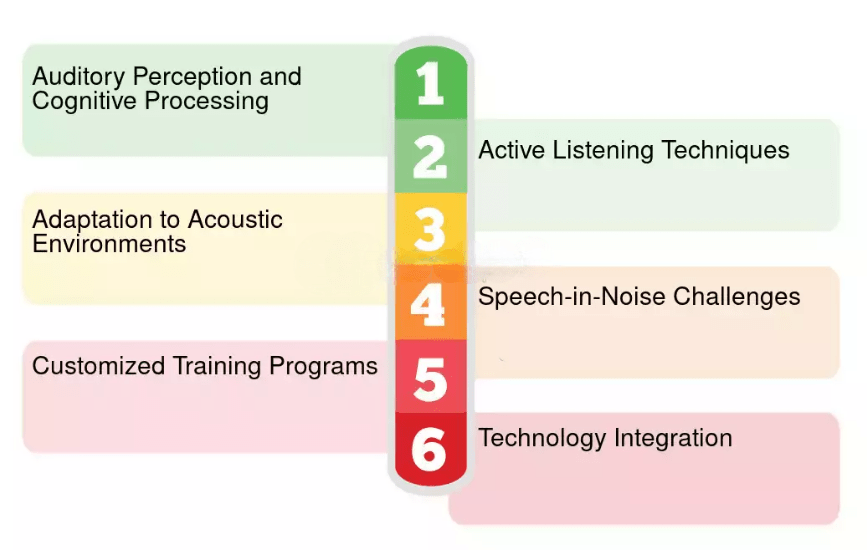
- Introduction to Hearing and Listening
- Definition of Hearing
- Definition of Listening
- Key Differences
- Importance in Business Communication
- Barriers to Effective Listening
- Active Listening Techniques
- Conclusion
Introduction to Hearing and Listening
Effective communication is fundamental to success in any professional environment, serving as the cornerstone for collaboration, decision-making, and relationship-building. Among the many components of communication, hearing and listening are frequently misunderstood or used interchangeably. However, they represent two distinct processes. Hearing is a passive physiological act, the ability to perceive sound. In contrast, listening is an active process that requires focus, interpretation, and response. In a business context, this distinction is critical. Simply hearing a message does not guarantee its understanding or application. Active listening involves paying full attention to the speaker, interpreting the message accurately, and providing thoughtful feedback. It fosters a deeper understanding, minimizes miscommunication, and builds trust among team members. Improving listening skills can lead to more effective meetings, clearer expectations, and stronger workplace relationships. For instance, leaders who listen actively are more likely to understand their team’s concerns, recognize potential problems early, and inspire greater engagement. Likewise, employees who listen attentively can better comprehend tasks, align with organizational goals, and contribute more meaningfully to discussions. Techniques to enhance listening include maintaining eye contact, avoiding interruptions, asking clarifying questions, and summarizing key points to ensure mutual understanding. In a fast-paced business world where distractions are constant, cultivating the habit of active listening can give organizations a competitive edge. Ultimately, by valuing and practicing true listening, professionals can enhance not just individual performance but also the collective success of their teams and companies.
Definition of Hearing
Hearing is a passive physiological process that involves the perception of sound through the auditory system. It occurs when sound waves travel through the air and are captured by the outer ear, then transmitted through the middle ear and finally interpreted by the brain. This process happens automatically and does not require conscious effort or attention. As long as the auditory system is functioning properly, an individual will hear sounds in their environment, regardless of whether they are paying attention to them or not. For example, someone might hear background noise, conversations, or traffic without intentionally focusing on any of these sounds. Hearing is simply the reception of auditory signals; it does not involve understanding, interpreting, or responding to those signals. It is an essential first step in communication but alone is not sufficient for meaningful interaction. The distinction between hearing and listening becomes crucial in professional and social contexts. While hearing allows a person to detect sounds, Listening Habits is what enables them to process and respond effectively to the information being conveyed. Without active listening, important messages can be missed or misunderstood, leading to miscommunication.

Therefore, while hearing is a basic and automatic function of the human body, it is only one part of the broader communication process. Recognizing this difference helps individuals become more aware of their communication habits and encourages the development of stronger, more intentional listening skills that are vital for effective interaction and collaboration in any setting.
Definition of Listening
- Active Engagement: Listening is not just about passively receiving sounds; it requires active engagement with the speaker and the message. This means paying full attention to what is being said without distractions.
- Concentration: Effective listening demands concentration. The listener must focus their mental energy on the speaker’s words, tone, and body language to fully understand the message being conveyed.
- Interpretation: Listening involves interpreting the sounds heard by making sense of the language, context, and meaning. This cognitive process helps the listener understand the speaker’s intent and emotions behind the message.
- Analysis: Beyond interpretation, listening includes analyzing the information to evaluate its relevance and accuracy. The listener assesses the message critically to form a clear understanding or to decide on an appropriate response.
- Memory Retention: A key part of listening is remembering the information communicated. Good listeners retain important details that allow them to respond appropriately and engage in meaningful conversations.
- Thoughtful Response: Listening requires preparing a thoughtful response, showing that the listener has understood the message. This can involve asking questions, providing feedback, or expressing empathy, which strengthens communication.
- Intentional Focus: Unlike hearing, which happens automatically, listening requires intentional focus. It is a deliberate effort to absorb, comprehend, and interact with the speaker’s message, making it a skill that can be developed and improved.
- Nature of the Process: Hearing is an involuntary, passive process that occurs naturally when sound waves reach the ears. Listening is an active and intentional process that requires focus and conscious engagement.
- Level of Attention Required: Hearing does not demand attention and can occur even when a person is distracted. Listening requires full attention to grasp and process the speaker’s message accurately.
- Effort Involved: Hearing requires no effort as it is an automatic bodily function. Listening involves mental effort, including concentration, interpretation, and active processing of information.
- Purpose: The purpose of hearing is to perceive sound. The purpose of listening is to understand messages, evaluate meaning, and respond appropriately to what is being communicated.
- Mental Engagement: Hearing engages the auditory system only. Listening involves deeper mental activity, such as analyzing tone, understanding context, and recognizing the speaker’s intent.
- Response and Feedback: Hearing often does not result in any feedback. Listening typically leads to responses such as asking questions, giving feedback, or taking informed action.
- Understanding and Interpretation: Hearing allows for sound recognition. Listening includes interpreting sounds, comprehending meaning, and making thoughtful judgments based on what is heard.
- Distractions (Physical and Mental): Distractions like background noise, mobile phones, or even internal thoughts can pull our focus away from the speaker. When the environment is noisy or the mind is preoccupied, it’s hard to fully absorb the message being delivered.
- Prejudgment or Bias: When listeners form opinions about the speaker or topic beforehand, they tend to filter or reject information that doesn’t align with their views. This closed mindset hinders genuine understanding and causes misunderstandings.
- Emotional Barriers: Strong emotions such as anger, stress, or sadness can cloud judgment and reduce listening effectiveness. When emotions run high, listeners may misinterpret the message or fail to listen objectively.
- Lack of Interest or Motivation: If the topic doesn’t feel relevant or engaging, listeners often lose focus. Without motivation or curiosity, attention wanes, leading to passive listening and poor retention of information.
- Interruptions and Assumptions: Interrupting the speaker or jumping to conclusions before they finish disrupts communication flow. It shows impatience and can prevent listeners from fully understanding the speaker’s message.
- Language and Vocabulary Differences: Use of complex terms, technical jargon, or unfamiliar accents can confuse listeners. When the language is not clear or accessible, it becomes difficult to grasp the intended meaning.
- Poor Listening Habits: Common habits like daydreaming, faking attention, or selectively hearing only parts of the message limit comprehension. Effective listening requires active engagement, which is often neglected.
Key Differences

Importance in Business Communication
In the context of business communication, listening plays a vital role in promoting clear and effective interactions between individuals and teams. It is more than just hearing words; it involves actively engaging with the speaker, understanding their message, and responding appropriately. Whether during meetings, negotiations, or everyday workplace conversations, Active Listening Techniques contributes to better comprehension, reduces the likelihood of misunderstandings, and helps build trust among colleagues. When team members truly listen to one another, they are more likely to share information openly, align on goals, and work collaboratively. This leads to more informed decision-making, increased productivity, and improved team dynamics. Active Listening Habits is especially important in client-facing roles, where communication quality directly impacts customer experience. Professionals who listen attentively can accurately identify client needs, concerns, and expectations. This allows them to respond with thoughtful solutions, demonstrate empathy, and provide a higher level of service. As a result, clients feel valued and understood, which fosters stronger relationships and long-term loyalty. Moreover, listening encourages a culture of respect and inclusion in the workplace. It signals that each person’s input is important and that diverse perspectives are welcomed. In fast-paced business environments, taking the time to truly listen can set individuals and organizations apart. It helps avoid costly errors, improves morale, and ultimately contributes to a more effective and harmonious work environment. Developing strong listening skills is not just a personal asset, it is a strategic advantage in today’s competitive business landscape.
Barriers to Effective Listening
Active Listening Techniques
Active listening is a vital skill for overcoming communication barriers and enhancing understanding between individuals. Developing effective listening skills requires intentional effort and the use of specific techniques. One important technique is maintaining eye contact. Eye contact signals attentiveness and respect, helping to build trust between the listener and the speaker. It shows the speaker that their message is being received with genuine interest. Another key aspect of active listening is focusing fully on the speaker. This means eliminating distractions such as phones, computers, or unrelated thoughts, and giving undivided attention to the person speaking. When the listener is truly focused, they are better able to absorb the message and respond thoughtfully. Asking questions is also essential to effective passive listening. Clarifying questions demonstrate engagement and help ensure that the listener fully understands the speaker’s points. This two-way interaction encourages clearer communication and reduces misunderstandings. Paraphrasing and summarizing what the speaker has said in one’s own words further confirms understanding. This technique shows respect for the speaker’s message and provides an opportunity to correct any misinterpretations early. Avoiding interruptions is crucial as well. Allowing the speaker to finish their thoughts without interruption fosters a respectful environment and encourages open dialogue. Finally, showing empathy is a powerful part of active listening. Recognizing and acknowledging the speaker’s feelings or perspective, especially during sensitive conversations, helps build rapport and trust. Together, these techniques form the foundation of active listening, which is essential for effective communication in both personal and professional settings.
Conclusion
In the fast-paced and often complex world of business, listening stands out as one of the most powerful tools for building strong relationships, making informed decisions, and fostering effective teamwork. Unlike hearing, which is a passive and automatic process, listening requires deliberate effort, attention, and intention. It involves not only receiving the message but also understanding, interpreting, and responding thoughtfully. In professional settings, the ability to listen actively can mean the difference between success and failure. Miscommunication can lead to errors, missed opportunities, and weakened relationships, while effective listening promotes clarity, trust, and collaboration. Recognizing the importance of listening is the first step toward improving communication skills. Many barriers can hinder effective listening, such as distractions, biases, or preconceived notions. Overcoming these barriers requires focus, openness, and a willingness to engage fully with the speaker. Active listening techniques, such as maintaining eye contact, asking clarifying questions, and paraphrasing, help ensure that the message is accurately received and understood. By practicing these skills, professionals can enhance their interactions with colleagues, clients, and partners. Improved listening leads to better problem-solving, stronger teamwork, and more meaningful connections. Beyond the workplace, passive listening also plays a critical role in personal growth and success. Investing time and effort into developing strong listening skills is not just a valuable professional asset; it is an essential ingredient for achieving lasting success and building meaningful relationships in any field.



